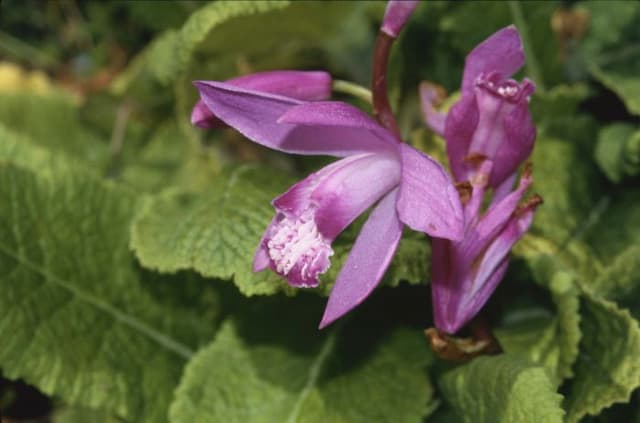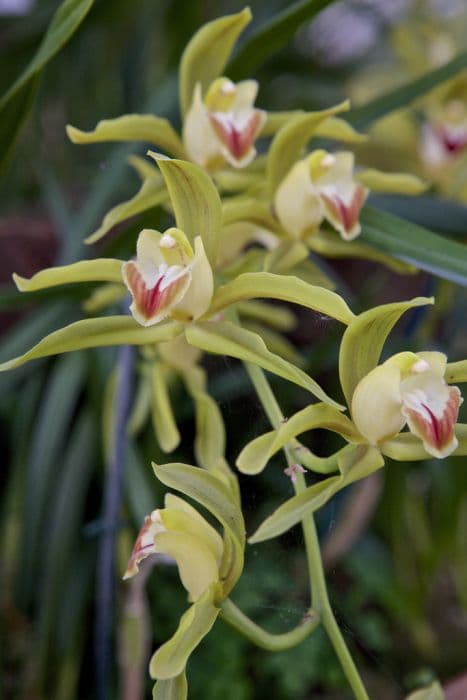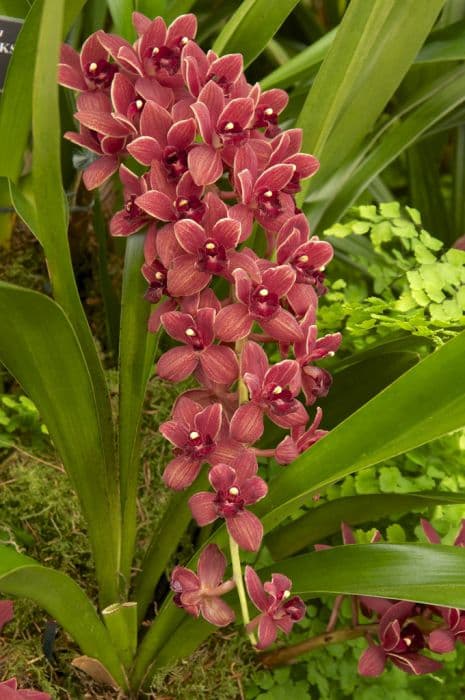Red Swan Oncidium × Oncidopsis Nelly Isler gx

ABOUT
× Oncidopsis Nelly Isler, commonly known as 'Nelly Isler,' is a vibrant and enchanting orchid hybrid that is adored by many for its striking flowers. This plant is a visual delight, characterized by its vividly colored blooms that exhibit a deep, rich red or burgundy hue, often complemented by a contrasting pattern of lighter veins or speckles. The color palette of the flowers can include shades ranging from fiery red to crimson, with some variations displaying a gradient of color intensity across the petals. The flowers of the Nelly Isler orchid are intricately designed with a harmonious blend of form and color, featuring a prominent lip often highlighted in a lighter tone, such as white or pale yellow, which serves as an alluring focal point. This lip is typically fringed or ruffled, adding a touch of elegance and texture to the overall appearance of the bloom. Surrounding the lip are the petals and sepals, which gracefully arch and curve to create an alluring display. Nelly Isler's blossoms are borne on sturdy, upright stems that emerge from a base of slender, elongated leaves. These leaves are a fresh green color, providing a perfect backdrop that accentuates the beauty of the flowers. The foliage is typically glossy, with a leathery texture, forming a clump from which the floral spikes arise. The plant's growth habit is such that it often produces multiple flowers on each stem, resulting in a spectacular cluster of color when in full bloom. The visually stunning flowers, combined with the plant's lush green foliage, make Nelly Isler a highly sought-after orchid variety for adding a splash of tropical flair and color to any indoor or outdoor space where it can thrive. As an orchid, it is also cherished for its potential long-lasting blooms, which can provide a display of color for several weeks, making it a popular choice among orchid enthusiasts and those looking to enhance their living spaces with living art.
About this plant
 Names
NamesFamily
Orchidaceae.
Synonyms
Red Butterfly Orchid, Nelly Isler Hybrid.
Common names
× Oncidopsis Nelly Isler gx.
 Toxicity
ToxicityTo humans
The plant known as Nelly Isler, which is a hybrid orchid, is not known to be toxic to humans. Consequently, there are no specific symptoms associated with poisoning because it is not considered poisonous. Generally, it is safe to handle and does not pose a threat if touched or ingested in small amounts. However, as with any plant, it is advisable to wash hands after handling and to avoid ingesting any part of the plant due to the potential for individual allergic reactions or gastrointestinal discomfort.
To pets
The Nelly Isler, a hybrid orchid, is typically not considered toxic to pets such as dogs and cats. There are no well-documented toxic effects or typical symptoms of poisoning from this plant in pets. While it is not believed to be poisonous, it is always best to prevent pets from ingesting plants as a precautionary measure, since individual animals might have sensitivities or reactions to plants that are generally regarded as non-toxic.
 Characteristics
CharacteristicsLife cycle
Perennials
Foliage type
Evergreen
Color of leaves
Green
Flower color
Red
Height
1-2 feet (30-60 cm)
Spread
1 foot (30 cm)
Plant type
Hybrid
Hardiness zones
10
Native area
Cultivar
Benefits
 General Benefits
General Benefits- Aesthetic Appeal: The Oncidopsis Nelly Isler, commonly known as "Nelly Isler," adds vibrant color and allure to your living space with its striking red and pink blooms.
- Psychological Well-being: Caring for a Nelly Isler orchid can provide a sense of accomplishment and can be therapeutic, thus promoting better mental health.
- Habitat Enrichment: When grown in outdoor gardens in suitable climates, this plant can provide habitat and food for local pollinators such as bees and butterflies.
- Educational Value: Orchid enthusiasts can learn about botany and the delicate balance of orchid care through the nurturing of Nelly Isler orchids.
- Humidity Control: Like many orchids, the Nelly Isler can help in maintaining humidity levels in a room, which can be particularly beneficial in dry climates or during winter months.
 Medical Properties
Medical PropertiesThis plant is not used for medical purposes.
 Air-purifying Qualities
Air-purifying QualitiesThis plant is not specifically known for air purifying qualities.
 Other Uses
Other Uses- The Oncidopsis Nelly Isler can be used in art and photography due to its vibrant red and burgundy blooms, providing an eye-catching subject or backdrop.
- As a teaching tool in horticulture and botany classes, it can illustrate hybridization and the complexity of orchid care and propagation.
- It's an ideal choice for creating living walls or vertical gardens in urban environments, bringing a splash of color to concrete landscapes.
- In perfumery, though not commonly used, some enthusiasts distill its subtle fragrance for bespoke or niche scents.
- This orchid can be used in eco-friendly packaging design where its image or dried petals may adorn sustainable materials.
- This plant acts as a muse for designers and fashion industry, inspiring prints and patterns for clothing and accessories.
- An educational tool for climate change awareness, it serves as an indicator for shifts in growing conditions for sensitive plant species.
- In culinary arts, its visual appeal is used by high-end restaurants to decorate plates and dessert presentations (Note: the plant itself is not edible).
- For event planning, particularly weddings and upscale parties, the Oncidopsis Nelly Isler is incorporated into floral arrangements and bouquets.
- Used in the production of botanical illustrations and detailed plant taxonomy books, due to its unique characteristics and striking appearance.
Interesting Facts
 Feng Shui
Feng ShuiThe Oncidium Orchid is not used in Feng Shui practice.
 Zodiac Sign Compitability
Zodiac Sign CompitabilityThe Oncidium Orchid is not used in astrology practice.
 Plant Symbolism
Plant Symbolism- Beauty: The flamboyant blooms and vibrant colors of the Cambria Orchid symbolize exquisite beauty and sophistication.
- Love: As with many orchids, the Cambria Orchid is often associated with love and affection, making it a popular gift between couples.
- Luxury: The Cambria Orchid's unique and exotic appearance often represents luxury and a taste for the finer things in life.
- Strength: Despite their delicate look, orchids are surprisingly resilient, and the Cambria Orchid symbolizes inner strength and the ability to withstand tough conditions.
- Mystery: With its exotic origins and rare beauty, the Cambria Orchid can symbolize mystery and fascination.
 Water
WaterThe Cambria orchid, commonly known as Nelly Isler, should be watered when the top inch of the potting medium starts to feel dry to the touch. Typically, this translates to watering once every 7 to 10 days, but the exact frequency depends on environmental factors such as temperature and humidity. Water the plant thoroughly, allowing the water to run through the pot's drainage holes, indicating that the medium is fully saturated. It's important not to let the plant sit in water as this can lead to root rot. The amount of water will vary based on pot size, but ensure that each watering provides enough moisture to reach all the roots. In most cases, using about 8-16 ounces of water every week or two should be sufficient, adjusted for the plant's size and environmental conditions.
 Light
LightThe Cambria orchid requires bright, indirect light to flourish. An ideal spot would be a windowsill facing east or west, where it can receive gentle morning or late afternoon sunlight. Direct midday sun can be too harsh and may burn the leaves, so it's vital to provide shade or use a sheer curtain to diffuse the light during peak hours. Adequate lighting is essential for the health and blooming of the Cambria orchid.
 Temperature
TemperatureThe Cambria orchid thrives in temperatures between 60 to 80 degrees Fahrenheit during the day and prefers a slight drop at night to around 55 to 65 degrees Fahrenheit. It can tolerate a minimum temperature of 50 degrees Fahrenheit, but temperatures below this can be harmful. Ideally, maintain an even temperature without sudden fluctuations to support the plant's health and flowering potential.
 Pruning
PruningPruning the Cambria orchid is important for removing any dead or yellowing leaves and spent flower spikes to encourage new growth and maintain a neat appearance. Prune after the flowering season is over, typically cutting back the flower spike to the nearest node using sterilized pruning shears. Doing this once a year, or as necessary when you see fading flowers or damaged foliage, helps promote the plant's vitality.
 Cleaning
CleaningAs needed
 Soil
SoilThe Red Cambria Orchid prefers a well-draining mix such as fine-grade orchid bark, charcoal, and perlite. Aim for a slightly acidic to neutral pH of 5.5 to 6.5.
 Repotting
RepottingRed Cambria Orchids should be repotted every 2 to 3 years or when the potting mix breaks down, whichever comes first.
 Humidity & Misting
Humidity & MistingRed Cambria Orchids thrive in environments with 40% to 70% humidity levels.
 Suitable locations
Suitable locationsIndoor
Place Red Cambria in bright, indirect light and maintain high humidity.
Outdoor
Only in warm, shaded areas with high humidity and no frost.
Hardiness zone
10-12 USDA
 Life cycle
Life cycleThe × Oncidopsis Nelly Isler, commonly known as Nelly Isler orchid, begins its life cycle as a seed, which after germination grows into a protocorm, a stage where the first roots and shoot develop. From the protocorm, it matures into a juvenile orchid plant with leaves and small pseudobulbs. As it enters adulthood, Nelly Isler orchids develop larger pseudobulbs and a robust root system, along with larger, more numerous leaves. The mature plant then enters its reproductive phase, where it produces striking red-and-pink flowers intermittently throughout the year, typically triggered by a drop in nighttime temperatures. After pollination, if it occurs, the flowers will develop into seed capsules containing countless minute seeds. Throughout its life, the plant continuously grows new pseudobulbs and leaves, which replace older ones that eventually die off, thus perpetuating the orchid's life cycle.
 Propogation
PropogationPropogation time
Spring-Early Summer
The popular method for propagating × Oncidopsis Nelly Isler, commonly known as Nelly Isler orchid, is division. This process is typically done during repotting which is best undertaken when new growth appears, often in the spring. To propagate by division, carefully remove the orchid from its container and gently separate the pseudobulbs, ensuring that each division has at least three healthy pseudobulbs and a good root system. Cut through the rhizome with a sterile tool to separate the sections. Afterwards, pot each division in appropriate orchid media, providing the same care as a mature Nelly Isler orchid. With proper care, these divisions will grow into new, independent plants.








